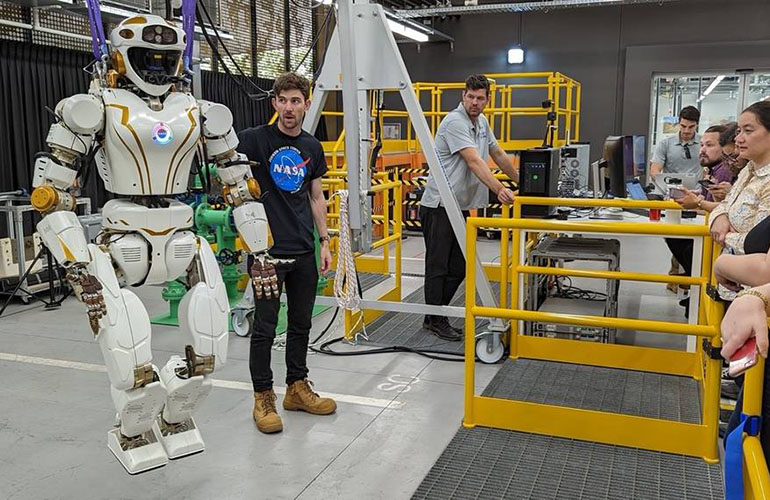|
Listen to this article  |

The Woodside Energy team received training on the Valkyrie robot. | Source: NASA/JSC
NASA’s humanoid robot, Valkyrie, is starting a new mission in Australia. The robot will put its skills to the test as part of a reimbursable Space Act Agreement with Woodside Energy in Perth, Western Australia.
The NASA dexterous robotics team from the Johnson Space Center in Houston traveled to the Woodside headquarters to deliver the robot. There, NASA will use Valkyrie to develop remote dexterous manipulation capabilities to accommodate remote caretaking of uncrewed and offshore energy facilities. Woodside Energy will then test the resulting software and provide data and feedback to NASA.
Valkyrie is designed to be a robust, rugged, and entirely electric humanoid robot that can operate in degraded or damaged human-engineered environments. It weighs around 300 lbs and is about 6 ft 2 in tall.
This project is NASA’s second reimbursable collaboration with Woodside. NASA said it hopes this collaboration will help Valkyrie advance remote robotic operations, which could help improve Woodside’s offshore and remote operations while also increasing safety for both personnel and the environment.
These new capabilities could also be applied to applications for NASA’s Artemis missions and for other Earth-based robotics objectives. In particular, NASA hopes to leverage its experience operating Valkyrie in Woodside’s facilities to learn how to better design robots for work in dirty and hazardous conditions.
“We are pleased to be starting the next phase of development and testing of advanced robotic systems that have the potential to positively impact life on Earth by allowing safer operations in hazardous environments,” Shaun Azimi, lead of the dexterous robotics team at NASA Johnson, said. “These demonstrations will evaluate the current potential of advanced robots to extend the reach of humans and help humanity explore and work safely anywhere.”
In the future, remotely-operated mobile robots on the Moon or Mars could allow Earth-based operators to conduct important activities when astronauts aren’t physically present. These activities could include inspection of maintenance of infrastructure and plans that leverage resources and materials to produce new items, enabling astronauts to live off the land.
NASA said Valkyrie and other advanced mobile robots could someday be vital tools that allow humans to supervise dangerous work remotely and offload dull and repetitive tasks. These capabilities can be used both on Earth and in space.
Credit: Source link


Comments are closed.